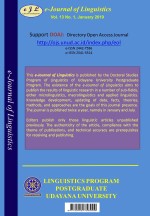The Verb “Memukul’ in the Balinese Language Dialect Spoken at Taro Village: A Natural Semantic Metalanguage Study
Abstract
The people living at Taro village speak the Balinese language as their daily language. As the speakers of the Balinese languge, they never neglect the speech order, as can be seen from the fact that they still use the Balinese words, which in the modern era, have been neglected, resulting in the fact that many people are not familiar with a number of words, especially those which belong to the verb word class, one of which is the verb “ngetok” (hit). The Balinese language has a great number of verbs; however, the current study only analyses the verb “ngetok’ (hit) using the theory of Natural Metalanguage Semantics (NMS). The verb “ngetok” (hit) has a great number of equivalents; they are ngebug, ngedig, nigtig, ngupek, megambel, mugpugin, mukpukin, ngukul, nungting, ngempug, nyakcak, noktok, ngeplokin, nebuk, ngaasin, nepung, ngintuk, ngalocok, namplak, nyemés, nempéléng, nyagur, nyepédin, nglamet, ngamplongin, ngamplengin, ngemplangin, nglentangin, ngaplekin, nyontok, nylimed and mentil. One verb is different from another, although they are all used to express the action of hitting something or someone, depending on what tool is used to hit and the subject and object which are hit. The verb “ngetok” (hit) in the Balinese language has two different meanings; namely doing something and taking place, which can be explained using the explication technique in which it is described that “X does something on Y, causing something either bad or good to occur to Y”. Such differences in meaning can be obtained through the analysis of the original meaning using the non-compositional polysemy
Downloads
References
Goddard, Cliff. 1996. Semantic Theory and Semantic Universal (Cliff Goddard Convensor)
Goddard, Cliff. 2002. The Search for theShared Semantics Core of All Lan-guage. Australia: University of New England
Kridalaksana, Harimukti. 2008. Kamus Linguistik. Edisi Keempat: PT Gramedia
Mulyadi, 1998. “Struktur Semantis Verba Bahasa Indonesia” Tesis S2, Linguistik Denpasar.
Sudipa, I Nengah. 2004. “Verba Bahasa Bali, sebuah Kajian Metabahasa Semantik Alami” Disertasi Doktor Linguistik-Denpasar.
Sudipa, I Nengah. 2011. Semantik Konsep Dan Aplikkasi Natural, Semantik Metalanguage (NSM). Denpasar: Program Pascasarjana Universitas Udayana.
Sudipa, I Nengah. 2012. Makna “Mengikat” Bahasa Bali: Pendekatan Metabahasa Semantik Alami 49-68. Denpasar: Jurnal Kajian Bali
Sutjiati-Beratha, NI, 1997. “Basic Concepts of a Universal Semantic Metalanguage” Linguistika 110-115. Denpasar Program Magister Linguistik UNUD.
Verhaar. J.W.M. 2008. Asas-Asas LinguistikUmum. Yogyakarta: Gaja Mada University Press.
Wierzbicka, Anna. 1996. Semantics: Prime and Universal. Oxford: Oxford University.

This work is licensed under a Creative Commons Attribution 4.0 International License











